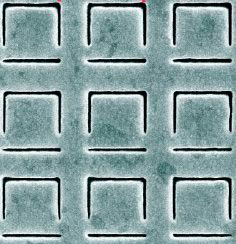
A new device that controls light using an array of tiny gold structures coated with carbon nanotubes has been developed by physicists in the UK and Italy. Based on a “photonic metamaterial”, the devices could find use in lasers and optical communications components.
Metamaterials are artificial materials containing arrays of tiny structures such as rods and rings that respond to light and other electromagnetic waves in unusual ways. For example, a metamaterial can be designed to have a refractive index that varies throughout the material, and which can even be negative in some cases. Such unique properties mean that metamaterials have already been used to make “super-lenses”, which beat the diffraction limit, and “invisibility cloaks” for microwaves.
The performance of such metamaterials has been limited by their relatively weak interaction with light. But now, Nikolay Zheludev and colleagues at the University of Southampton and researchers at the Italian Institute of Technology in Catanzaro have found a way around this problem by creating a new hybrid metamaterial that combines carbon nanotubes and a metamaterial made of gold. The resulting composite has an enhanced response to light – that is, its refractive index changes very strongly and quickly compared to other metamaterials when exposed to a light beam. Indeed, it reacts in less than a picosecond, as opposed to microseconds for liquid crystals, for example.
Groovy gold
The team fabricated the metamaterial in two stages. They began with a thin flat layer of gold that they bombarded with a beam of gallium atoms to cut grooves about 25 nm wide. The grooves formed a regular array with each unit cell comprising a square with 500 nm sides, two of which are broken (see “Array of squares cut into gold”).
This structure is called a “plasmonic metamaterial” because its optical properties involve surface plasmons. These are collective oscillations of electrons on the surface of a metal that interact with light. Next, the team sprayed a solution of carbon nanotubes – tiny tubes with walls just one atom thick – onto this metamaterial and then dried it to create a fuzzy layer about 50 nm thick. They call this layer a nanoscale “feutre” from the French for felt.
CNTs were used because they possess unique nonlinear optical properties, and interact with both light and plasmons. They are also simple and cheap to make, robust and can easily be integrated into waveguides and other photonic devices.
q-switching components
The resulting structure could be used to make optical limiters, which are components that prevent a surge of power in optical networks. They could also find use in “mode-locking” and “q-switching” components of lasers that allow short pulses to be generated; as well as nanoscale circuits that process optical data signals.
Akhlesh Lakhtakia of Penn State University told physicsworld.com that using carbon nanotubes in this way is an important first step towards creating commercial devices based on structured metallic inclusions, adding that the nanotubes could also effectively compensate for optical losses in finished devices.
Zheludev’s team now plans to develop other types of nonlinear, switchable and controllable metamaterials.
The work is described in Phys. Rev. Lett. 104 153902.




